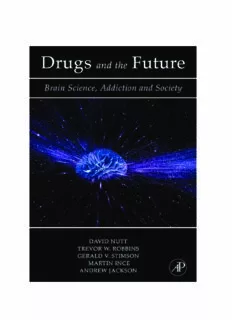Table Of ContentDRUGS AND THE
FUTURE:
BRAIN SCIENCE, ADDICTION
AND SOCIETY
Drugs and the Future:
Brain Science,
Addiction and Society
Scientific Coordinators
D N
AVID UTT
PsychopharmacologyUnit,UniversityofBristol,UK
T W. R
REVOR OBBINS
DepartmentofExperimentalPsychologyandMRC
CentreforBehaviouralandClinicalNeuroscience,UniversityofCambridge,UK
G V. S
ERALD TIMSON
InternationalHarmReductionAssociation,Melbourne,Australia
M I
ARTIN NCE
ScienceWriter,London,UK
and
A J
NDREW ACKSON
DepartmentofTradeandIndustry,UK
AMSTERDAM • BOSTON • HEIDELBERG • LONDON
NEWYORK • OXFORD • PARIS • SANDIEGO
SANFRANCISCO • SINGAPORE • SYDNEY • TOKYO
AcademicPressisanimprintofElsevier
WhiletheOfficeofScienceandInnovationcommissionedaportionofthesereviews,the
viewsarethoseoftheauthors,areindependentofGovernmentanddonotconstitute
governmentpolicy.
AcademicPressisanimprintofElsevier
30CorporateDrive,Suite400,Burlington,MA01803,USA
525BStreet,Suite1900,SanDiego,California92101-4495,USA
84Theobald’sRoad,LondonWC1X8RR,UK
Thisbookisprintedonacid-freepaper.
Copyright©Queen’sPrinterandControllerofHMSO,2007. PublishedbyElsevierLtd.
Allrightsreserved.
Nopartofthispublicationmaybereproducedortransmittedinanyformorbyany
means,electronicormechanical,includingphotocopy,recording,oranyinformation
storageandretrievalsystem,withoutpermissioninwritingfromthepublisher.
PermissionsmaybesoughtdirectlyfromElsevier’sScience&TechnologyRights
DepartmentinOxford,UK:phone: (+44)1865843830,fax: (+44)1865853333,
E-mail:[email protected]. Youmayalsocompleteyourrequeston-line
viatheElsevierhomepage(http://elsevier.com),byselecting‘Support&Contact’
then‘CopyrightandPermission’andthen‘ObtainingPermissions.’
LibraryofCongressCataloging-in-PublicationData
Applicationsubmitted
BritishLibraryCataloguing-in-PublicationData
AcataloguerecordforthisbookisavailablefromtheBritishLibrary.
ISBN13: 978-0-12-370624-9
ISBN10: 0-12-370624-6
ForinformationonallAcademicPresspublications
visitourWebsiteatwww.books.elsevier.com
PrintedintheUnitedStatesofAmerica
06 07 08 09 10 9 8 7 6 5 4 3 2 1
Contents
Contributors vii 10 DrugTesting 315
DavidCowan,DavidOsseltonandStevenRobinson
Foreword ix
11 SocialPolicyandPsychoactive
CharlesR.Schuster
Substances 337
RobinRoom
Introduction xi
SirDavidKing 12 SociologyandSubstanceUse 359
NeilMcKeganey,JoanneNeale,CharlieLloyd
Acknowledgements xiii
andGordonHay
1 DrugsFutures2025 1 13 EconomicsofAddictionandDrugs 389
DavidNutt,TrevorRobbinsandGerryStimson JonathanCaveandChristineGodfrey
2 Foresight 7 14 ProblemGamblingandOtherBehavioural
AndrewJackson Addictions 417
JimOrford
3 NeuroscienceofDrugs
andAddiction 11 15 EthicalAspectsofDevelopmentsin
TrevorRobbins,RudolphCardinal,Patricia NeuroscienceandDrugAddiction 439
DiCiano,PeterHalligan,KimHellemans, RichardAshcroft,AlastairV.Campbelland
JonathanLeeandBarryEveritt BenCapps
4 Genomics 89 16 HistoryandtheFutureofPsychoactive
DavidBall,MarcusPembreyandDavidN.Stephens Substances 467
VirginiaBerridgeandTimHickman
5 ExperimentalPsychologyandResearchinto
BrainScience,AddictionandDrugs 133 17 LifeHistoriesandNarratives
TheodoraDuka,BarbaraSahakianand ofAddiction 485
DanielleTurner Brian Hurwitz, Caroline Tapping and Neil Vickers
6 PharmacologyandTreatments 169 18 DrugsFutures2025? Perspectiveofthe
LeslieIversen,KellyMorrisandDavidNutt PharmaceuticalIndustry 507
IanRagan
7 PsychologicalTreatmentsofSubstance
MisuseandDependence 209 19 TheScenarios 535
ValCurranandColinDrummond OfficeofScienceandInnovation
8 CognitionEnhancers 241
AuthorIndex 567
RoyJones,KellyMorrisandDavidNutt
SubjectIndex 597
9 Neuroimaging 285
HughGaravan,AnneLingford-Hughes,TerryJones,
PeterMorris,JohnRothwellandSteveWilliams
v
Contributors
RichardAshcroft ColinDrummond
ImperialCollege,London,UK StGeorge’sHospitalMedicalSchool,
London,UK
DavidBall
King’sCollege,UniversityofLondon,UK TheodoraDuka
UniversityofSussex,UK
VirginiaBerridge
LondonSchoolofHygieneandTropical BarryJEveritt
Medicine DepartmentofExperimentalPsychology
London,UK andMRCCentreforBehaviouraland
ClinicalNeuroscience
AlastairVCampbell UniversityofCambridge,UK
CentreforEthicsinMedicine
UniversityofBristol,UK HughGaravan
TrinityCollege,Dublin,Eire
BenCapps
UniversityofBristol,UK ChristineGodfrey
UniversityofYork,UK
RudolfNCardinal
DepartmentofExperimentalPsychology PeterWHalligan
andMRCCentreforBehaviouraland SchoolofPsychology
ClinicalNeuroscience CardiffUniversity,UK
UniversityofCambridge,UK
GordonHay
JonathanCave CentreforDrugMisuseResearch
UniversityofWarwick,UK UniversityofGlasgow,UK
DavidCowan KimGCHellemans
UniversityofLondon,UK DepartmentofExperimentalPsychology
andMRCCentreforBehaviouraland
ValCurran ClinicalNeuroscience
UniversityCollege,London,UK UniversityofCambridge,UK
PatriciaDiCiano TimHickman
DepartmentofExperimentalPsychology UniversityofLancaster,UK
andMRCCentreforBehaviouraland
ClinicalNeuroscience BrianHurwitz
UniversityofCambridge,UK King’sCollege,UniversityofLondon,UK
vii
viii
CONTRIBUTORS
LeslieIversen MarcusPembrey
UniversityofOxford,UK UniversityofBristol,UK
AndrewJackson IanRagan
OfficeofScienceandInnovation, CIRConsultingLtd,
DepartmentofTradeandIndustry,UK London,UK
RoyJones TrevorW.Robbins
TheResearchInstituteforthe DepartmentofExperimentalPsychology
CareoftheElderly,Bath,UK andMRCCentreforBehaviouraland
ClinicalNeuroscience
TerryJones UniversityofCambridge,UK
UniversityofManchester,UK
StevenRobinson
JonathanLCLee ForensicScienceService,UK
DepartmentofExperimentalPsychology
andMRCCentreforBehaviouraland RobinRoom
ClinicalNeuroscience SchoolofPopulationHealth,Melbourne
UniversityofCambridge,UK University,andAERAlcoholPolicy
ResearchCentre,TurningPoint
AnneLingford-Hughes Alcohol&DrugCentre,Melbourne,
UniversityofBristol,UK Australia
CharlieLloyd JohnRothwell
York,UK UniversityCollege,London,UK
NeilMcKeganey BarbaraSahakian
CentreforDrugMisuseResearch UniversityofCambridge,UK
UniversityofGlasgow,UK
DavidN.Stephens
KellyMorris UniversityofSussex,UK
UniversityofBristol,UK
GeraldV.Stimson
PeterMorris InternationalHarmReductionAssociation,
UniversityofNottingham,UK Australia
JoanneNeale CarolineTapping
SchoolofHealthandSocialCare King’sCollege,UniversityofLondon,UK
OxfordBrookesUniversity,UK
DanielleTurner
DavidNutt UniversityofCambridge,UK
UniversityofBristol,UK
NeilVickers
JimOrford King’sCollege,UniversityofLondon,UK
Alcohol,Drugs,GamblingandAddiction
ResearchGroup,SchoolofPsychology, SteveWilliams
UniversityofBirmingham,UK InstituteofPsychiatry,UK
DavidOsselton
ForensicScienceService,UK
Foreword
Drugs and the Future
CharlesR.Schuster,PhD
DistinguishedProfessorofPsychiatryandBehavioralNeurosciences
WayneStateUniversitySchoolofMedicine
The use of psychotropic drugs to modify agents might be useful for improving nor-
sensation, perception, mood, and behaviour mal performance. Extensive research has
hasbeenubiquitousinhumansocietiessince demonstrated that certain medications can
time immemorial. Alcohol, caffeine, coca, enhance cognitive and motor task perfor-
nicotine, opium, peyote, marijuana, mesca- mance that has been degraded by fatigue or
line and many other substances have been boredom. The United Sates Department
usedinavarietyofculturesintheworldfor of Defense, for example, sanctions the use
religious ceremonies, healing by shamans, ofsuchdrugsforpilotswhomustremainon
or as a brief escape from the rigours of duty for extended periods of time. Now,
a difficult existence. The scientific devel- however, we are faced with the likelihood
opment of safe and effective psychotropic ofdiscoveringnewpsychotropicagentsthat
drugs for the treatment of psychiatric and will augment the optimal performance of
neurological disorders is, however, a rel- non-disordered individuals, allowing them
atively recent phenomenon. Only in the to work not only longer, but also more effi-
past50yearshavewedevelopedhighlyspe- ciently and productively. It is also likely
cific and effective drugs for the treatment that we will develop – through rational
of neurological and psychiatric disorders. design or serendipity – psychotropic agents
Progress is being made in our understand- that can enhance such human qualities as
ing of the pathophysiology of neurodegen- empathy, sympathy, spirituality, and com-
erative and psychiatric disorders including passion. Psychotropicdrugshavebeenused
substance abuse and dependence. Coinci- by many to enhance creativity, with mixed
dentwiththesesignificanttherapeuticgains, results. Undoubtedly, as we continue main-
we are learning more about the fundamen- stream development of psychotherapeutic
talneuralmechanismsunderlyingcognition, agents, new ‘psychedelic’ agents will also
motor function, perception, motivation, and be discovered. This will force us to give
mood states. Unquestionably, we will see serious reconsideration to the manner in
continued progress in our understanding of whichweviewtheuseofcurrentlyavailable
the etiology of neurological and psychiatric ‘psychedelic’ agents that in most countries
diseasestatesand,hopefully,inthedevelop- are banned as illegal drugs. Could these
mentofwaystopreventandmoreeffectively compounds and ones yet to be discovered
treat these problems. In so doing we will lead to more creative thinking in the arts
inexorably discover new means to alter our and sciences? Could they increase spiritu-
mood,perceptionsandcognition. ality and feelings of compassion for the less
We have in the past generally dis- fortunate? If they do, how will or should
counted the possibility that psychotropic theseagentsbesanctionedandregulated?
ix
Description:This book presents 13 reviews collected to present the new advances in all areas of addiction research, including knowledge gained from mapping the human genome, the improved understanding of brain pathways and functions that are stimulated by addictive drugs, experimental and clinical psychology ap

